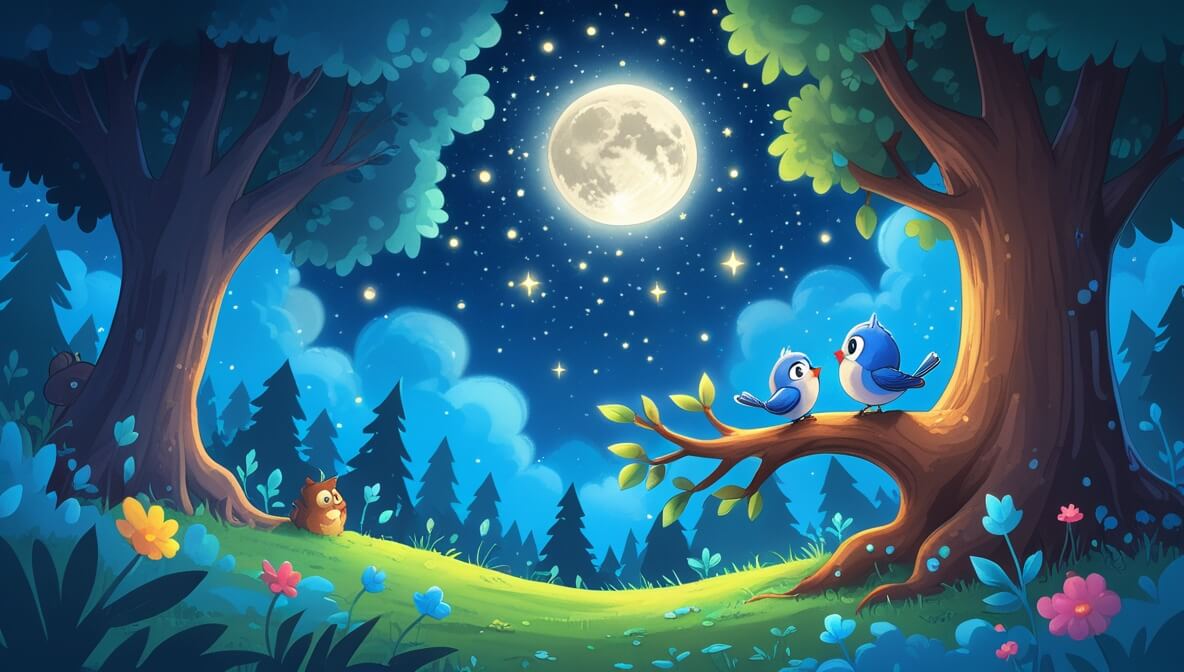A tiny bluebird named Flappy and a wise old tree named Oakley discover the wonders of the night sky and learn about the magic of bedtime routines.
Age Recommendation
0 – 4 years
Characters
Characters:
- Flappy (a cheerful bluebird with a curious heart)
- Oakley (a wise old tree who loves to share stories)
Story
Flappy the bluebird fluttered from branch to branch, excited to see his friend, Oakley the tree. “Tell me a story about the stars,” chirped Flappy.
The night sky’s dance
Oakley smiled and began, “When the sun goes to sleep, the stars come out to play. Each star shines bright, like a little night-light in the sky.” Flappy’s eyes widened as he looked up. “Wow, they twinkle like magic!” he exclaimed.
Moon’s gentle glow
As the moon rose, Oakley continued, “The moon is like a big, friendly face watching over us. It bathes the world in its gentle glow, helping everyone feel safe and calm.”
Dreamland whispers
“And when the stars sing a lullaby,” Oakley said softly, “everyone drifts off to sleep. The moon and stars guide us to dreamland, where we can imagine anything.” Flappy closed his eyes, feeling cozy and warm.
The end.
Moral of the Story
Bedtime is a magical time for winding down and dreaming big. It’s important to follow a cozy routine and let your imagination take flight.
Questions to Think About
- Why do you think the stars twinkle in the sky?
- What stories would you ask Oakley to tell?
- How do you feel when you see the moon?
- What do you dream about at night?
- Why is it important to have a bedtime routine?
Do You Know
- The moon does not produce its own light; it reflects the light of the sun.
- Stars are like big, faraway suns shining in the night sky.
Word Explorer
- Twinkle: To shine with a light that changes or moves.
- Glow: A soft, steady light.
- Dreamland: A magical place you go to in your dreams.
Emotions in the Story
- Curiosity: Flappy felt curious when he wanted to learn about the stars.
- Wonder: Flappy felt wonder when he saw the stars twinkle.
- Calmness: Flappy felt calm as Oakley shared the stories of the night sky.
Color Your Scene
Imagine the night sky full of twinkling stars and a bright, friendly moon. Draw Flappy sitting on one of Oakley’s branches, looking up in awe. Use lots of dark blues for the sky and bright whites and yellows for the stars and moon.
Parents’ Corner
This story is a wonderful way to introduce children to:
Bedtime routines: Establishing a consistent, calming routine can help children transition to sleep more easily.
Imagination: Encourage your child to create their own stories about the stars and the moon, fostering creativity and storytelling.
Nature appreciation: Spend a few moments observing the night sky with your child, pointing out stars, planets, and the moon, helping them connect with the world around them.











